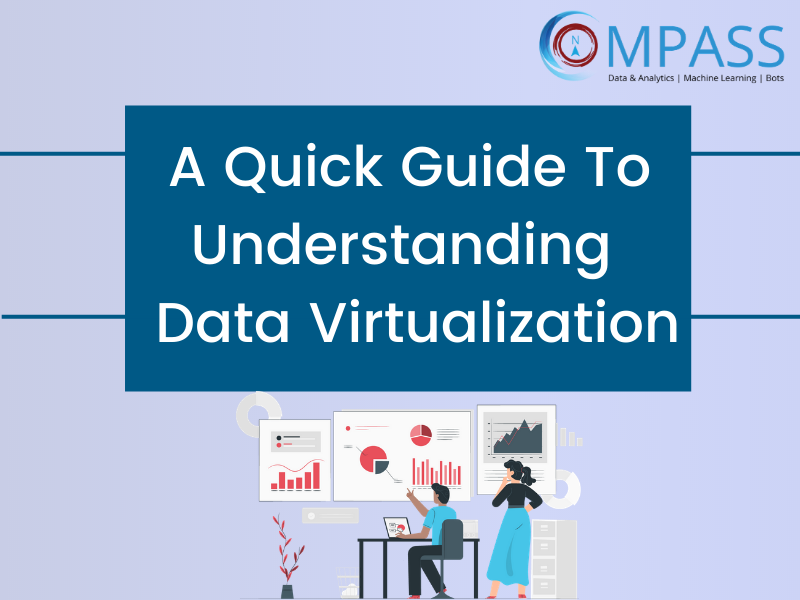Enterprises today need faster access to real-time data to solve some of the most pressing business challenges and stay competitive. However, the number of data persistence options continue to grow due to today’s application ecosystem. These options include NoSQL databases, on-premise data warehouses, relational databases and so on.
While it’s beneficial to have a local copy of data, there are also several challenges associated with it:
- Data sources can’t be easily understood or controlled
- There is a huge lag in data movement
- Building data integration patterns takes more time
- The right infrastructure should be available
Data Virtualization offers a viable solution for this problem.
What is Data Virtualization?
A Data Virtualization (DV) platform combines siloed data sources to create a single view of data for consumption. It does this without having users to copy or move data from source systems.
You can have a unified, organized and comprehensive version of data from unstructured and structured sources while keeping your data in source systems. This solves the data movement challenge and ensures business users have seamless access to real-time data. DV enables an application to retrieve and manipulate data without requiring its technical details like physical location, data formatting information, security and configuration settings, etc.
In the areas of business intelligence, app development and big data analytics, a DV platform can be considered as an alternative to extract-transform-loads (ETLs) and data warehousing.
What Data Virtualization Is Not
The concept of Data virtualization is usually associated with several misnomers and confusions. Here are some common ones.
Data Virtualization ≠ Data Visualization
Even though both the words rhyme with each other and sound similar, data virtualization and visualization are quite different in their very nature.Data visualization is related to representation of data using charts, graphs, tables etc. On the other hand, a data virtualization platform acts as a middle ware and data service provider to data visualization applications.
Data Virtualization ≠ Replicated Data Store
Remember, a DV platform just uses metadata about the data and integration logic for viewing – it doesn’t replicate source data.
Data Virtualization ≠ Virtualized Data Storage
Some people use “Data Virtualization” to refer to virtualized database software or storage hardware virtualization solutions. But these solutions don’t have the needed capabilities to provide real-time data integration and data services across multiple data sources.
11 Key Benefits of Data Virtualization
- DV platforms reduce data preparation time and enable quick business decisions. This provides a competitive advantage to industries like CPG, retail, banking etc. where real-time data is critical for decision making
- DV eliminates data silos. It federates and aligns all your data sources into a unified consumable data model
- By reducing data duplications and errors, DV brings down data warehousing and data management maintenance costs.
- DV is much less expensive to maintain than traditional integration tools
- It boosts performance and provides a seamless way for data management
- It allows self-service BI and secure data governance
- It gives better context to big data
- DV lowers systems workload by reducing data movement
- Reduced development and support time
- It provides easy access to real-time data
- It uses a schema-based approach to combine the semantic understanding of data from unstructured and web sources
5 Top Data Virtualization Tools You Can Consider
Denodo

Denodo helps you not only virtualize data but also identify and catalog the different types of data you have. The tool provides a semantic search query feature to find data and understand how data is being used by different users and apps. Compliance and data privacy concerns can be addressed with the tool’s integrated data governance capabilities.
Red Hat JBoss Data Virtualization

Red Hat is a good choice if your organization is heavily dependent on developers and uses microservices and containers. The Eclipse Integrated Developer Environment (IDE) based Graphical User Interface (GUI) makes developers’ job easy and allows them to leverage their existing tools and skills.
TIBCO Data Virtualization

TIBCO acquired Cisco’s data virtualization tool in 2017 and made steady improvements since then. The tool can discover relationships between data and makes it easier for administrators and users to design a virtual data layer. It also provides a transformation engine to combine different types of non relational and unstructured data together. It enables users to build data views by choosing from a data directory.
Oracle Data Service Integrator

If you’re already using Oracle business intelligence and analytics softwares, then implementing Oracle Data Service Integrator for data virtualization is a no brainer. The tool can analyze data from a multitude of sources and supports a variety of business use cases. Users can automate service integration through the tool’s graphical modelling capabilities. The tool is also equipped with robust security features including rule-based security policies and sophisticated auditing of data usage.
IBM Cloud Pak for Data

IBM Cloud Pak for Data is an integrated platform which provides both data collection and analysis capabilities. Previously known as IBM Cloud Private for Data, the tool provides superior controls for data access and governance. It includes a drag and drop interface with which you can connect data and perform sophisticated ETL activities for data preparation. It also features an enterprise-grade data catalogue to collect and analyze data.
Wrapping Up
Gartner projects that by 2020, 35 percent of enterprises will implement data virtualization as an alternative to data integration. DV is a mature data integration methodology that is supporting several operational and analytics use cases for businesses. The need for seamless access to real-time data with minimum data movement is propelling the growth of the DV market.
If you’d like to learn more about this topic, please feel free to get in touch with one of our data virtualization experts for a personalized consultation.
You may also be interested in exploring our business intelligence and analytics services for further insights.



